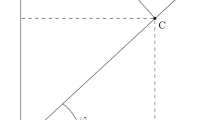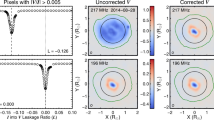Abstract
The High Altitude Observatory Coronagraph/Polarimeter, to be flown on the National Aeronautics and Space Administration's Solar Maximum Mission satellite, is designed to produce images of the solar corona in seven wavelength bands in the visible spectral range. The spectral bands have been chosen to specifically exclude or include ‘chromospheric’ spectral lines, so as to allow discrimination between ejecta at high (coronal) and low (chromospheric) temperatures, respectively. In addition, the instrument features spectral filters designed to permit an accurate color separation of the F and K coronal components, and a narrow band (5.5 Å) filter to observe the radiance and polarization of the Fe xiv 5303 Å line. The effective system resolution is better than 10 arc sec and the instrument images a selected quadrant (or smaller field) on an SEC vidicon detector. The total height range that may be recorded encompasses 1.6 to more than 6.0R ⊙ (from Sun center). The instrument is pointed independently of the SMM spacecraft, and its functions are controlled through the use of a program resident within the onboard spacecraft computer. Major experimental goals include: (a) Observation of the role of the corona in the flare process and of the ejecta from the flare site and the overlying corona; (b) the study of the direction of magnetic fields in stable coronal forms, and, perhaps, ejecta; and (c) examination of the evolution of the solar corona near the period of solar maximum activity.
Similar content being viewed by others
References
Blackwell, D. E., Dewhirst, D. W., and Ingham, M. F.: 1967, Adv. Astron. Astrophys. 5, 1.
Gosling, J. T., Hildner, E., MacQueen, R. M., Munro, R. H., Poland, A. J., and Ross, C. L.: 1975, Solar Phys. 40, 439.
Hildner, E., Gosling, J. T., MacQueen, R. M., Munro, R. H., Poland, A. J., and Ross, C. L.: 1976, Solar Phys. 48, 127.
Hundhausen, A. J.: 1972, Coronal Expansion and Solar Wind, Springer-Verlag, New York.
MacQueen, R. M., Gosling, J. T., Hildner, E., Munro, R. H., Poland, A. J., and Ross, C. L.: 1974, Proc. S.P.I.E: 44, 207.
Munro, R. H., Gosling, J. T., Hildner, E., MacQueen, R. M., Poland, A. L., and Ross, C. L.: 1979, Solar Phys. 61, 201.
Saito, K.: 1970, Ann. Tokyo Astron. Obs., Ser. 2, 12, 53.
Author information
Authors and Affiliations
Additional information
The National Center for Atmospheric Research is sponsored by the National Science Foundation.
Rights and permissions
About this article
Cite this article
MacQueen, R.M., Csoeke-Poeckh, A., Hildner, E. et al. The High Altitude Observatory Coronagraph/Polarimeter on the Solar Maximum Mission. Sol Phys 65, 91–107 (1980). https://doi.org/10.1007/BF00151386
Received:
Revised:
Issue Date:
DOI: https://doi.org/10.1007/BF00151386




